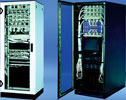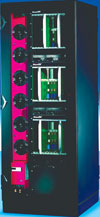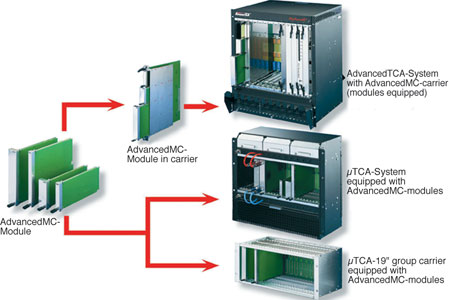
Cabinet systems for telecom applications are used for the housing of active and passive components such as servers, patch panels, switches and structured cabling.
In order to house large volumes of copper and LWL cables, the cabinets have to withstand high load carrying on the one hand, and on the other, have to offer good accessibility and installation-friendly solutions for structured cable guidance and fixing.
Important are assembly possibilities for 19" and ETSI standards, but also, integration of non-standard components. Furthermore, the cabinets should have the smallest 'footprint' possible, still allowing for the best possible amount of assembly space. This is relevant for outdoor and indoor cabinets. Of course it goes without saying that the functionality of such cabinets is most important, but the appearance must not be undervalued. To fulfil the varied design requests of customers, telecom cabinets should be flexible here. The outside of the cabinets does need to blend into the complete picture of the location.
Outdoor telecom cabinets
With outdoor applications in particular, extreme environmental conditions always have to be taken into account. Decisions about the selection of material and finishes, mechanical stability, cooling, cable guidance etc, are influenced eg, by cold, sun radiation, snow, sand, insects, rodents, vandalism and vibration.
For these applications Schroff has two standardised outdoor cabinet versions: Modular and Unibody.
The modular version is based on an aluminium extruded frame, which has a high flexibility with regard to the cabinet dimensions and at the same time allows good accessibility from all sides. The lower priced unibody version is based on a single-part aluminium inner housing, which is particularly suited for smaller dimensions for wall, pole and ground assembly. Both cabinet versions protect the assembled components from wind, rain, heat, cold and vandalism. They have flexible assembly possibilities for 19", ETSI or other, non-standard accessories.
The cabinets, whose standardised components are based on IEC 61 969, fulfil the guidelines and standards for shock and vibration stability, earthquake stability and offer climate protection tested to IEC 68-2-1, -2, -14. Through the double panel construction of the outside of both cabinet versions a certain amount of heat can be expelled without additional cooling components (such as fans, heat exchangers or climate control units). Furthermore, the overheating of the enclosure due to sun radiation is reduced to a minimum. The double panel concept also protects the assembled components from mechanical damage. There are no visible screws and assembly elements, whereby unauthorised access is avoided. The hinged roof construction enables simple installation and maintenance of fans and peripheral equipment, whereas the base allows for easy cabling, but still maintains good protection against insects and rodents.
Also, not to be underestimated, is the possible noise pollution occurring near the location of such outdoor cabinets. Therefore, Schroff has taken particular care to adhere to national and international noise pollution regulations. In the case of actual air cooling with fans, the fan speed is regulated by intelligent algorithms, so that the set limits for the noise level for day and night operation are observed.
Indoor telecom cabinets
In telecom applications different cabinet types (distributor, data and server cabinets) are used. Schroff's flexible Varistar cabinet platform fulfils all these versions. It consists of a frame, which is made in two different versions, multiple cladding options and an extensive range of assembly and accessory parts. The two frame versions differ in their maximum load-carrying capacity, either up to 400 kg (Slim-Line) or 800 kg (Heavy-Duty). Additionally the Slim-Line frame is suitable for an ETSI assembly.

The outer dimensions of both versions correspond to the ETSI standard. All cover parts, such as doors, side and rear panels, top and base plates can be combined with both frame versions, achieving a continuous, unified appearance. The Varistar platform has been tested in all important areas: EMC, stability, shock and vibration, etc, by independent test laboratories. Dynamic tests to earthquake stability Bellcore, Zone 4, confirm possible global deployment.
Structured cable management
In particular for cable management, cable guidance and fixing, often very different concepts exist for simple, structured and easily changeable and upgradeable cable guidance that can be changed during operation. Basically one finds three types of cables in a telecom cabinet: copper and fibre data cables as well as power cables. These cables can withstand mechanical stress to different levels and have to be arranged without twisting, pulling, pressure and tension inside the cabinet. Unprofessional treatment and arrangement alters the electrical and optical properties of the cables and thereby reduces the transfer bandwidths and ranges.

The cable arrangement in Varistar distinguishes the different areas. In four defined zones, the guidance and fixing of all cables is guaranteed. Zone 1 is located in front of the assembled components in the 19" plane. Here, patch cables are directed horizontally between the distribution fields. Zone 2 is to the right and left next to the 19" platform, the patch cables are guided vertically in a rising duct between the individual components. In zone 3, which stretches at the side behind the 19" plane across the cabinet depths, data cables are guided from the openings in top or bottom panels to the rear sides of the distribution fields. Zone 4, at the rear of the cabinet, serves as an alternative to zone 3 for 600 mm deep cabinets or when the cabinet is not accessible from the rear due to its location. Generally, the zone 4 openings in the top cover are used for active cooling with the aid of installed fans. This becomes necessary when also active components are installed in the cabinet apart from passive components.
Fixing and guidance elements
In zones 1 and 2 the cables are usually arranged loosely, as the cabling is changed quite frequently through patches. In 90% of cases the tension release in zone 3 is realised with C profiles; the cable bundles are secured safely with suitable clamps.
Schroff has developed further, simpler, but effective solutions for the individual zones for Varistar. The patch cables in zone 1 are directed horizontally and loosely to zone 2 in cable guides made from round steel or plastic. In zone 2 cable eyes in three different sizes, depending on the cabinet dimensions, are used. For the classic 800 mm wide and 800 mm deep network cabinet in zone 2, an area of 100 x 150 mm (W x D) can be used. These bundles can be secured in the 25 mm grid of the frame or at the side of the 19" plane. For very large numbers of cables a bracket is available, with dimensions of 100 x 300 mm (W x D) that reach far into zone 3.
Cooling of high performance systems
Digital transmission systems are replaced more and more by server-based systems. Here, too, topics relating to effective cooling, noise level and radiation are coming even more into the foreground. The previously used, room-dependent cooling concepts with air cooling are no longer sufficient for these new high performance systems. As the performance capacity of servers increases further, their dimensions become smaller and more compact. There are servers around today which have a performance loss of 4 or 5 kW. With a fully-assembled cabinet the limits for air cooling are reached quickly. From 1500 W/m² it is no longer economical to deploy room dependent cooling concepts. An alternative is the combined air/water fluid cooling with water as a medium. Through the closed circuit of an air/water heat exchanger a cooling solution is created, independently from the area.
With the air/water heat exchanger in the Varistar LHX 20, Schroff has developed a cooling concept as a complete solution for cabinets. This complete system is able to expell installed performance losses of up to 20 kW. The air/water heat exchanger is assembled as a complete module in the left or right part of the cabinet. The module consists of a self-supporting enclosure, the air/water heat exchanger, droplet collector, six fans, a three-way valve as well as an electronic control unit with operating and display elements. By assembling the air/water heat exchanger on the side, the 19" plane is utilised to its full height. With side-by-side cabinets all cabinets can be cooled with one air/water heat exchanger.

The heat exchanger is located within the closed air circuit inside the cabinet, with an air flow volume up to 3000 m³/h. Air flow elements and six fans which are distributed over the entire height, guarantee even cooling of all installed components. The cooling water flows through an external water circuit and the heat exchanger heats up during that process and flows back to the chiller, where it is brought down to the required operating temperature. The temperature in the cabinet is controlled with a microprocessor.
If people are working in the immediate environment of such systems, the noise pollution is a deciding criterion. The generated noise level through the cooling components must not be underestimated. Varistar with LHX reaches values of only 50,7 dB(A) at 80% capacity and 54,8 dB(A) at 100 % capacity. With this, even the location in an office environment is possible. The legally determined limit is 55 dB(A) (DIN EN ISO 11650-1).
New form factors: AdvancedTCA and MicroTCA
A large part of present telecom systems is still based on proprietary designs. The disadvantages of this practice are high development costs and long manufacturing times. This is also relevant for the enclosures technology, which as a rule has to be adapted to these proprietary designs.
The first step of the telecom industry to pull away from proprietary systems and use standard platforms was the CompactPCI packed-switching standard. But the limits of this standard were reached relatively quickly. The next, and obviously successful step, was the AdvancedTCA standard. This standard (PICMG3.0 Rev.2.0) offers the advantage of scalable architecture, which supports a multitude of standardised interfaces. Furthermore, it provides an effective capacity for data transfers up to 2,5 Tb/s (for instance for Video on Demand, Wireless IP, Voice over IP, switches, routers and other network applications), as well as a high availability of the systems. Additionally, different protocols (such as Ethernet (PICMG 3.1), InfiniBand (PICMG 3.2), Star Fabric (PICMG 3.3), PCI Express (PICMG 3.4) and Rapid I/O (PICMG 3.5) for fast interfaces are supported.
The AdvancedTCA standard PICMG 3.x was issued in December 2002. Meanwhile this standard is recognised for telecom applications and integrators; and manufacturers replace proprietary solutions with AdvancedTCA. The only downside: for the periphery these high performance AdvancedTCA computers are extremely efficient and with this correspondingly expensive.

In the periphery areas of telecom networks there are fewer connections that need to be switched to other cables, but there, higher computing rates are required, for instance for coding data. Therefore smaller systems are required with high performances and less switching power. For these requirements the MicroTCA standard (PICMG MicroTCA.0 R1.0) was developed. It aims mainly at applications in the access area, in base-stations and in internal telecommunication networks of companies of medium or large size. Typical applications are, for example, Base Transceiver Stations, VoIP Gateways, WiMAX solutions or software-based IP telephone systems. These new standards make the development of future secure telecom systems easier and more cost effective. On the basis of these standards Schroff offers not only cabinet solutions, complete subrack systems including backplanes but also single components.
| Tel: | +27 11 608 3001 |
| Email: | [email protected] |
| www: | www.actum.co.za |
| Articles: | More information and articles about Actum |

© Technews Publishing (Pty) Ltd | All Rights Reserved